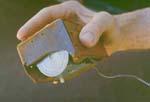
It's networking
OUR COVERAGE:
Part 1: A virtual unknown
Part 2: Against all odds
Part 3: Debunking the legend of the mouse
Part 4: The crusade
Part 5: It's networking
Part 6: A pioneers' reunion
Tech pioneers
"What did you think would happen after the demo?" I ask as Engelbart flicks off his computer in preparation for a photo shoot later that morning - he's won another award and a picture is needed for the awards program. Wistfully, he answers, "I thought corporations and researchers would say, 'Aha!' and a movement to change the way we knowledge-work would get going."
Not exactly.
Over the following two decades, he kept handing industry giants the next great idea - actually about 20 paradigm-shifting ideas - the kind of ideas venture capitalists consider the Holy Grails of technology. And they kept handing them back. Engelbart eventually lost his government funding, his team defected and his lab was shut down.
"I'm not surprised by the way he was treated. The vision he had was too far out there," observes Silicon Valley archiver Tim Lenoir, professor of history and philosophy of science at Stanford University. Or, in futurist Saffo's words, "It [the demo] was like a UFO landing on the White House lawn." The idea of cheap PCs was science fiction in an era of multimillion-dollar mainframes.
"I'm not surprised by the way he was treated. The vision he had was too far out there."
Tim Lenoir,
Stanford University
professor of historyInitially, the landmark demo buoyed Engelbart's reputation, making it easier to win more government funding. The Augment system helped support the ARPA network. Work slowly started on personal computers as Xerox PARC researchers began to build a prototype, but the price - about $10,000 - still made it impractical for consumers.
Meanwhile, Engelbart kept insisting that collaboration, not people working alone on desktops, was the end goal. But by the late 1970s, the supposed visionaries of technology were tuning out his message, dismissing Engelbart as a pioneer who'd never moved on.
"I was stigmatized. In some quarters, there were serious questions about my sanity and my integrity," he observes. Why did he continue? "I didn't have enough imagination to think of a better goal."
Being stigmatized is one thing, being homeless is another. In 1976, fire destroyed Engelbart's Atherton home. Over the next three years, the Engelbarts would live in 16 temporary homes while theirs was rebuilt. A month after the fire, the federal government cut off funding for Augment. By 1977, SRI was preparing to mothball Engelbart's revolution. He had no money to keep it going on his own.

Engelbart's original mouse,
built in 1963-64. Two
perpendicular wheels
underneath tracked motion.
Subsequent versions had
three buttons.
It's hard to imagine a technology innovator today losing total control over such groundbreaking inventions. So I suggest the obvious, "Couldn't you have made money off the mouse?" "Even though my name was on the patent, SRI, the research organization, owned it. This was standard practice at the time," he says.He did make some money off his invention. In the early '80s, SRI wrote Engelbart a check for $10,000 in a show of appreciation.
Engelbart wasn't preoccupied with money, but with saving Augment. SRI agreed to sell the system in 1977 to Tymshare, a phone networking company interested in Augment for office automation. Engelbart, the only remaining member of his research team, went along. He explains, "I went and stayed and stayed because that system represented a real outpost from where I thought we could go."
But he was alone in the commercial desert. Tymshare wouldn't support more research. He had a small cubicle in a Cupertino low-rise office building, one block from Apple Computer, where Jobs was launching the PC revolution.
Some nights he would wake up in a cold sweat. "I'd say, 'It's suicide to keep doing this.' Then I'd go through the reasons again." His reasoning goes like this: "Every year sooner" that the world learns how to tackle problems collectively, then every year sooner the odds increase that we can cope before "complex problems crash our whole society."
Nobody ever accused Engelbart of worrying about the small stuff.
When aeronautical conglomerate McDonnell Douglas Corp. acquired Tymshare in 1984, Engelbart was treated, in his words, "like a strange coding adviser." He tried to convince managers that they could improve productivity by using an internal computer network to collaborate and swap information. Engelbart was talking about an intranet - an innovation that caught on in corporations about three years ago.
"I showed them how it could change the way they did their design work and support for buyers," Engelbart says. "Some people got excited. But then upper management canceled it. One guy said, 'IBM and Hewlett-Packard aren't using this sort of thing. I can't believe it's worth doing.'"